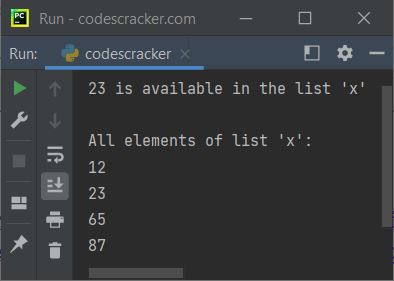- Python Basics
- Python Tutorial
- Python Applications
- Python Versions
- Python environment setup
- Python Basic Syntax
- Python end (end=)
- Python sep (sep=)
- Python Comments
- Python Identifiers
- Python Variables
- Python Operators
- Python Ternary Operator
- Python Operator Precedence
- Python Control and Decision
- Python Decision Making
- Python if elif else
- Python Loops
- Python for Loop
- Python while Loop
- Python break Statement
- Python continue Statement
- Python pass Statement
- Python break vs. continue
- Python pass vs. continue
- Python Built-in Types
- Python Data Types
- Python Lists
- Python Tuples
- Python Sets
- Python frozenset
- Python Dictionary
- List vs. Tuple vs. Dict vs. Set
- Python Numbers
- Python Strings
- Python bytes
- Python bytearray
- Python memoryview
- Python Misc Topics
- Python Functions
- Python Variable Scope
- Python Enumeration
- Python import Statement
- Python Modules
- Python operator Module
- Python os Module
- Python Date and Time
- Python Exception Handling
- Python File Handling
- Python Advanced
- Python Classes and Objects
- Python @classmethod Decorator
- Python @staticmethod Decorator
- Python Class vs. Static Method
- Python @property Decorator
- Python Keywords
- Python Keywords
- Python and
- Python or
- Python not
- Python True
- Python False
- Python None
- Python in
- Python is
- Python as
- Python with
- Python yield
- Python return
- Python del
- Python from
- Python lambda
- Python assert
- Python Built-in Functions
- Python All Built-in Functions
- Python print() Function
- Python input() Function
- Python int() Function
- Python len() Function
- Python range() Function
- Python str() Function
- Python ord() Function
- Python chr() Function
- Python read()
- Python write()
- Python open()
- Python Examples
- Python Examples
Python in Keyword
The "in" keyword in Python is used when we need either:
- to check whether a particular value is available in a sequence such as a list, tuple, etc. or not.
- or to traverse a sequence in for loop
For example:
x = [12, 23, 65, 87] if 23 in x: print("23 is available in the list 'x'") else: print("23 is not available in the list 'x'") print("\nAll elements of list 'x':") for e in x: print(e)
The output of the above program is shown in the screenshot below to show how the "in" keyword works in Python:

Note: Python is a case-sensitive language; therefore, keep both the letters of "in" in small letters.
Python in Keyword Example
Here is an example of the "in" keyword in Python:
x = (134, 54, 65, 67, 0, 23) print("Enter a Number: ", end="") num = int(input()) if num in x: print("\nThe number is available") else: print("\nThe number is not available") print("\nEnter a String: ", end="") str = input() print("\nCharacters of given string are:") for c in str: print(c)
A sample run with user input 66 as a number and Python as a string is shown in the snapshot given below:

The "in" keyword can be thought of as a membership operator that returns True or False depending on whether or not the value is in the container.
Advantages of the "in" keyword in Python
- It's a clear way to check a container's value.
- It works with Python lists, tuples, sets, and dictionaries.
- It makes conditional statements and loops more efficient and readable.
Disadvantages of the "in" keyword in Python
- For large datasets, searching for a value in a container with the "in" keyword can be slow. Binary search or hash tables may be faster.
- It can only check for a value in a container, not its location or frequency.
- It may not work with custom classes or objects, which may require custom "in" implementation.
« Previous Tutorial Next Tutorial »